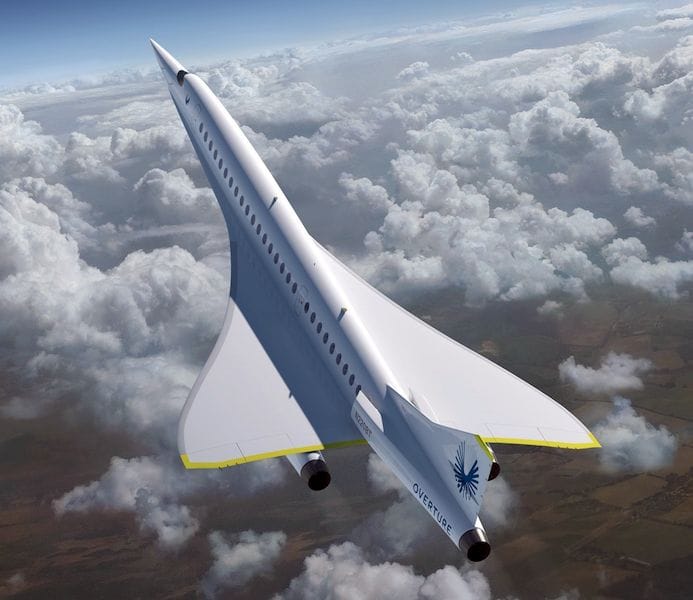![The Boom Supersonic Overture supersonic airliner will be made from 3D printed parts by Stratasys [Source: Boom Supersonic]](https://fabbaloo.com/wp-content/uploads/2020/05/image-asset_img_5eb095a098706.jpg)
Stratasys today announced a key contract with Boom Supersonic.
Stratasys had previously been working with Boom, but it seems that the supersonic aircraft developer was sufficiently satisfied with Stratasys’ product they decided to make a long-term arrangement.
If you’re not familiar with Boom Supersonic, they are a Colorado-based startup that believes they can find a way to produce a supersonic airliner. This type of aircraft has been avoided for literally decades after the Concorde experience.
The ill-fated Concorde, on which I flew once long ago, had several extremely difficult challenges. The sonic boom noise generated by the craft’s supersonic speed caused most jurisdictions to ban it from over-land flight, dramatically reducing its financial potential. As well, the Concorde was designed in an era of cheap oil, and little consideration was done regarding efficiency. It was incredibly expensive to fly.
Because of those challenges and others, the aerospace industry has mostly ignored the idea of supersonic flight ever since.
But recent advancements in manufacturing and design technologies have opened the door to several previously “impossible” projects, including private spaceflight, autonomous vehicles and many more. One more impossible project is to create an efficient, quiet and very fast supersonic airliner.
Building a Supersonic Airliner
That’s the mission of Boom Supersonic. They are working on a prototype aircraft, the XB-1, which is apparently being rolled out sometime later this year, with plans to fly it at supersonic speeds some time in 2020. That’s not very far off.
Following the test flights, Boom will continue to develop their production aircraft, the Overture. It’s intended to be a 55-75 passenger plane (somewhat less than Concorde), and with a maximum long-range cruising speed of an incredible Mach 2.2, or 2335kph for a range of 17,000km.
It’s intended to be an option for those who would normally fly in business class on today’s subsonic jets. Thus the seats would be priced higher on Overture flights, but only compared to economy ticket levels. If Boom can achieve this goal, then buyers would have a choice of either a slow journey or a fast one, both at a comparable price. I know what I would choose if facing that question.
![Concept interior for the Overture supersonic airliner [Source: Boom Supersonic]](https://fabbaloo.com/wp-content/uploads/2020/05/boom-supersonic-airliner-interior-3_img_5eb095a0df60e.jpg)
Where does Stratasys fit into all this? They don’t yet offer a metal 3D printer, so instead they’re focusing on the interior components. These are quite important for the business class audience expected to consider flying on Overture.
Certified 3D Printed Aircraft Parts
A couple of years ago Stratasys worked very hard to develop a Fortus 900mc Aircraft Interiors Certification Solution, which was a collection of printers, materials, processes, documentation and more that allowed an aircraft manufacturer to achieve the necessary certifications for 3D printed production parts.
![3D printed parts for a supersonic airliner [Source: Stratasys]](https://fabbaloo.com/wp-content/uploads/2020/05/boom-supersonic-parts1_img_5eb095a134abf.jpg)
Their “AIS” (Aircraft Interiors Solution) program basically took away a huge amount of work a manufacturer would have to go through to enable the use of 3D printing on a production aircraft project. As I’ve said before, if you want something to happen, make sure it’s easy — and that is precisely what Stratasys has done here.
The AIS allows not only 3D printing of parts, but also enables a future digital inventory approach by the manufacturer, who would not need to pre-make thousands of spare parts for the expected lifetime of the aircraft. Instead, they simply keep the digital file safe and can re-print the components anytime — and be assured they are certified for use.
![3D printed parts for a supersonic airliner [Source: Stratasys]](https://fabbaloo.com/wp-content/uploads/2020/05/image-asset_img_5eb095a175a81.jpg)
The arrangement with Boom extends for seven years, which should be sufficient for Boom’s use of the technology for the Overture aircraft, at least for its initial rollout. If successful, I could see the aircraft manufacturer continuing use of Stratasys equipment for many years as a key partner in a digital inventory process.
It also affirms industry long term interest in the certified 3D printed part process developed by Stratasys. This has been used by a few other manufacturers, and the trends look good for Stratasys on this venture.
Via Stratasys and Boom Supersonic











Eric Haddad is the founder and Pilot in Command of 3DAeroventures, a Texas-based outfit specializing in 3D printed RC aircraft.